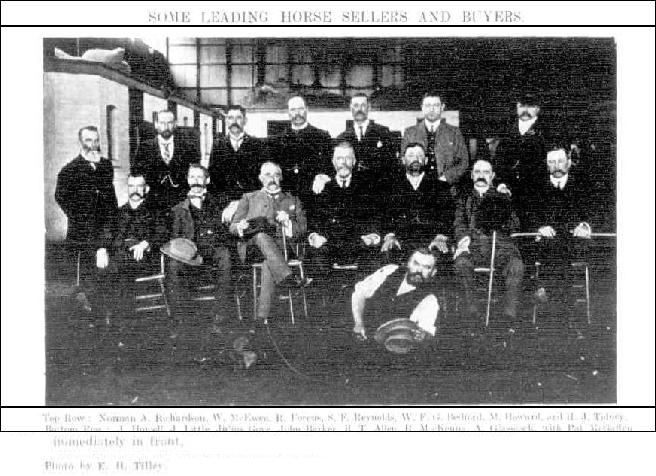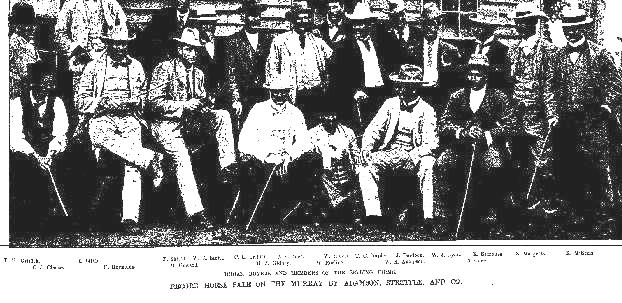Julius Gove

© Janet Lane walers.blogspot.com Image: SOME LEADING HORSE SELLERS AND BUYERS, Adelaide Observer, August 1903. Top Row : Norman A. Richardson, W. McEwen, R. Forcus, S. F. Reynolds, W. F. G. Bedford, M. Howard, and H. J. Tidney. Bottom Row : J. Howell. J. Little. Julius Gove, John Barker, R. T. Allen. R. McKenna. A. Glasscock, with Pat McGaffen immediately in front.
1854-1922. Gove had his own company, Julius Gove and Co., and specialised in shipping to Bombay. He created such a sound company, it traded on long after his death – with A.E. Young doing a lot of the work including training the polo ponies in India reported going there in 1929 and 1931 with horses, and as late as 1947 Mr. E. Whitlock Jones sent a consignment from Adelaide to Bombay on the Umaria, among them 15 grey officers chargers, the horses bought from Paratoo Station for the company. Another shipment had just left for the company on the horse ship Querida. Julius’ son Robert Gove was working for the company too – about 1933, in the depression, the Maharaja of Bharatpur swapped him a luxury automobile for a good horse; the car, a Horsch, caused a sensation in Melbourne. In 1935 Robert Gove said the company was sending between 800 and 1,500 horses annually to Bombay.
Julius Gove would go to sales and select about 1,500 horses at the start of the season, and travel over with a load. From the port of Bombay, his horses were sent by train to his own lands and stables a few miles from the city. In 1929, A. E. Young, one of his company, said they sent 1,500 horses that year to India – one third as polo mounts and hacks, one third for the native regiments in the Indian states and one third for the British army.

Gove drove a hard bargain and wouldn’t budge on price whether selling or buying. His motive was always profit and he worked hard for it. He and Jim Love were the two hard men of the game. However, Gove had immense respect and also made sure his family shared his wealth. They moved in the highest circles in India and Australia. Originally from Gippsland, Gove travelled within Australia, buying India horses in South Australia and racing some there too.
Two of his sons were in the Bombay Light Horse – the youngest son Captain Robert Vivian Gove married Alf Glasscock’s youngest daughter, Hope June; they lived at Malabar Hill, Bombay: another unification of horse trading empires through marriage.
All Julius Gove’s children grew up playing polo with their father and training ponies to sell – another son became Prince Charles’ polo coach. Tragically, there was also family grief. One son, Charles Clitus Gove, was kicked in the head by a horse in Queensland, a bad injury. When he recovered he sailed to India but died there not long after arriving, of infection after an appendicitis operation, in 1922, he was aged only 33; he left a widow Daisie and child Charles. Charlie had been a pilot in WW1.
Julius himself didn’t live to see this tragedy, he’d died unexpectedly himself in April – he’d been to the races to see one of his horses run on Saturday, and died the following Sunday morning at home, Canterbury Road, St Kilda.
He’d raced horses and had some handy jumpers and runners. He had an excellent reputation for supplying top racehorses to his Indian customers too.
In India he owned a commercial set up for selling and training – Gove’s stables were said to be the most palatial and most modern in all western India. Like most traders he made sure his horses got used being confined, and to the feed they’d have on ship, as well as eating from troughs and haynets, and drinking from buckets, before they were shipped.
Here the horses were given time to recover and stretch their legs from the long voyage, then a team of syces set to work sprucing them up for sale – they were described as “equine Beau Brummels.” Once ready, they were presented to visitors. Polo ponies, pig-stickers, remounts, carriage horses – he had a reputation for the best. Buyers came from all over India for his horses and he got tremendous prices, army buyers and private.
Gove shipped regularly to keep a good supply in his stables over the season. If he sold out, or was about to, he’d send to other buyers in Australia for more, trusting implicitly in their judgment.
Gove himself trained polo ponies while in India, to achieve better prices with game ready mounts. A.E. Young was part of the company and went to India with the horses too. He also trained polo horses. They stayed in India several months over the season. Gove bought horses off the track in India if they could turn a profit – either re-trained for polo or selling to studs. He had a good eye for a horse.
His wife Catherine died soon after Julius did, and a month after their son Charlie; in January 1923, at the marital home, Claremont, Canterbury Road, St Kilda. It must have been a tough time for the family left. Five children of the marriage were Theo, Daisie, Charlie, Cyril and Bob. When Julius died in April 1922, he was 67 years old. A grand horse trader.